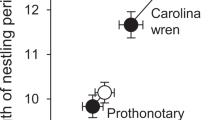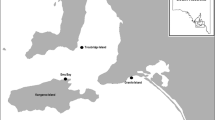Abstract.
White-browed sparrow-weavers (Plocepasser mahali, body mass 40 g) are group-living passerines adapted to the semi-arid environment of north-eastern and south-western Africa. During winter, the nocturnal ambient temperature of these regions often falls below 0 °C, imposing conditions demanding an increase in thermoregulatory heat production. Individuals roost throughout the year in inverted U-shaped roost nests. We investigated the energetic advantages of roosting by measuring nest and ambient temperatures in the field, as well as the resting metabolic rate (RMR) of the birds. The sparrow-weavers exhibited a wide thermoneutral zone (13 °C–32 °C). Although RMR at thermoneutrality (40.2 J g.h–1) conforms with those of other passerines, the value at 0 °C (74.8 J g.h–1) is significantly lower than expected. The slope of the line below the lower critical temperature is unexpectedly steep, however, and appears to cause the physiological requirement for nest roosting due to a high cost of thermoregulation at low temperatures, perhaps due to shivering or non-shivering thermogenesis. The nest temperature at 0 °C ambient is 5 °C, resulting in a saving of some 7% in the energy spent during winter nights when food resources are in short supply compared with the rest of the year.
Similar content being viewed by others
Author information
Authors and Affiliations
Additional information
Electronic Publication
Rights and permissions
About this article
Cite this article
Ferguson, .J., Nijland, .M. & Bennett, .N. Simple roost nests confer large energetic savings for sparrow-weavers. J Comp Physiol B 172, 137–143 (2002). https://doi.org/10.1007/s00360-001-0236-x
Accepted:
Issue Date:
DOI: https://doi.org/10.1007/s00360-001-0236-x




